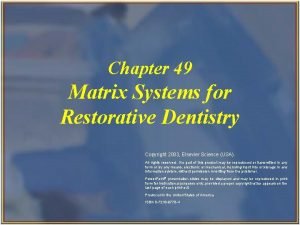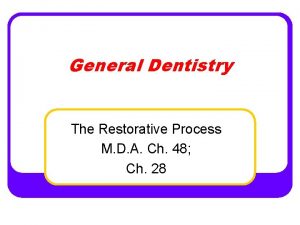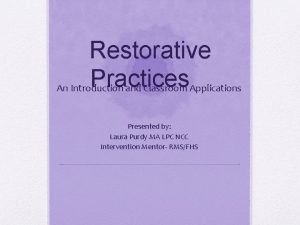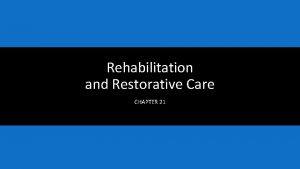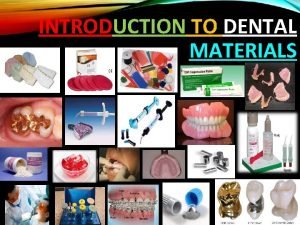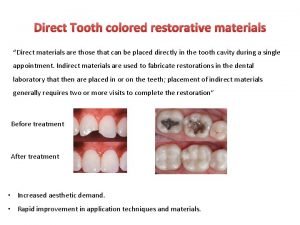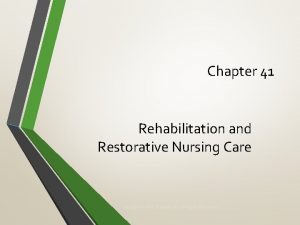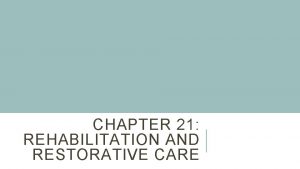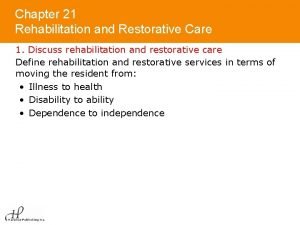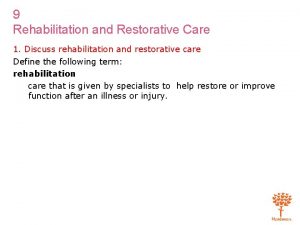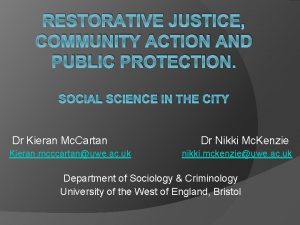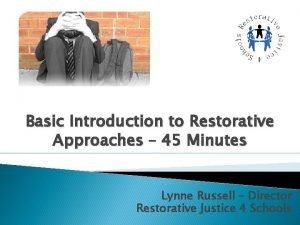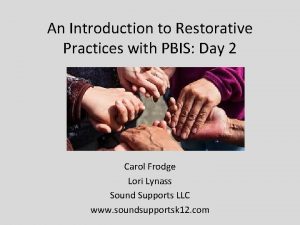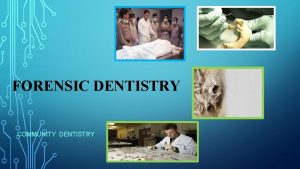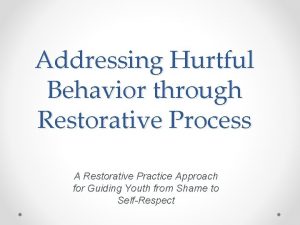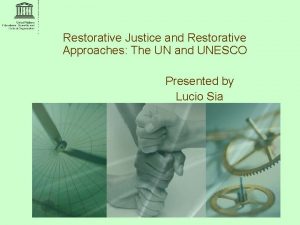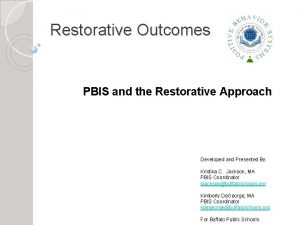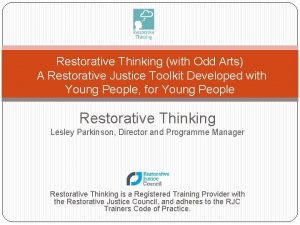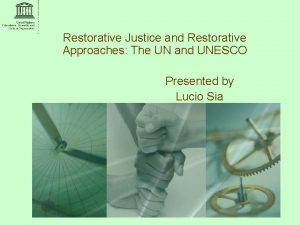General Dentistry The Restorative Process M D A

































- Slides: 33

General Dentistry The Restorative Process M. D. A. Ch. 48; Ch. 28

Restorative Dentistry l Specific conditions that initiate a need for restorative dental treatment are: • Initial or recurring decay • Replacement of failed restorations • Abrasion or the wearing away of tooth • structure Erosion of tooth structure

Esthetic Dentistry l Specific conditions that initiate a need for esthetic dental treatment are: • Discoloration due to extrinsic or intrinsic • • • staining Anomalies due to developmental disturbances Abnormal spacing between teeth Trauma

Terminology in Cavity Preparation

Initial Cavity Preparation l Outline Form • l Resistance Form • l Shape and placement of cavity walls Retention Form • l Design and initial depth of sound tooth structure To resist displacement or removal Convenience Form • Provides accessibility in preparing restoring tooth

Final Cavity Preparation l l l Removal of decayed dentin, or old restorative material Insert resistance and retention with the use of hand cutting instruments and burs Placement of protective materials (liners, bases, desensitizing or bonding)

Patient Preparation for Restorative Procedures l l l Inform the patient what to expect throughout the procedure. Position the patient correctly for the dentist and the type of procedure. Explain each step to the patient as the procedure progresses.

Responsibilities of the Chairside Assistant l l l Prepare the setup for the procedures. Know and anticipate the dentist's needs. Provide moisture control. Transfer dental instruments and accessories. Mix and transfer dental materials. Maintain patient comfort.

Steps in the Restorative Procedure l Dentist evaluates the tooth to be restored. l Dentist obtains local anesthesia. l Assistant readies the type of moisture control. l Dentist prepares the tooth. l Dentist determines the type of dental materials. l Assistant mixes and transfers the dental materials. l Dentist burnishes, carves, or finishes the dental material. l Dentist checks the occlusion of the restoration. l Dentist finishes and polishes the restoration.

Class I Restorations l l Class I lesion affecting the pit and fissures of the teeth Surfaces involved are: • Occlusal pits and fissures of premolars and molars • Buccal pits and fissures of mandibular molars • Lingual pits and fissures of the maxillary molars • Lingual pits of maxillary incisors, most frequently in the pit near the cingulum

Fig. 48 -5 Class I restoration

Class II Restorations l l Class II lesion is the extension of the Class I lesion into the proximal surfaces of premolars and molars. Surfaces involved: • Two-surface restoration of posterior teeth • Three-surface restoration of posterior teeth • Four- or more surface restoration of posterior teeth

Fig. 48 -6 Class II restorations (From Baum L et al: Textbook of operative dentistry, ed 3, Philadelphia, 1995, Saunders. )

Class III and IV Restorations l Class III Lesion • Affects the interproximal surface of incisors and canines l Class IV Lesion • Involves a larger surface area, which includes the incisal edge and interproximal surface of incisors and canines

Fig. 48 -7 Class III restoration (From Baum L et al: Textbook of operative dentistry, ed 3, Philadelphia, 1995, Saunders. )

Fig. 48 -8 Class IV restoration (From Baum L et al: Textbook of operative dentistry, ed 3, Philadelphia, 1995, Saunders. )

Class V Restorations l Class V Restoration l These decayed lesions occur at: • Classified as a smooth surface restoration • Gingival third of the facial or lingual • surfaces of any tooth Root of a tooth, near the cementoenamel junction

Fig. 48 -9 Class V restoration (From Baum L et al: Textbook of operative dentistry, ed 3, Philadelphia, 1995, Saunders. )

Recording the Dental Examination l Specific criteria required to know prior to charting: • Black’s classification of cavities • Tooth diagrams • Tooth numbering systems • Color coding • Charting

Fig. 28 -7 Black’s classification of cavities

Fig. 28 -8 Anatomic diagram for charting

Fig. 28 -9 Geometric diagram for charting

Fig. 28 -10 A, Universal numbering system

Fig. 28 -10 B, ISO/FDI numbering system

Fig. 28 -9 C, Palmer Notation System

Fig. 28 -11 Color coding in charting (Courtesy of Eaglesoft)

Soft Tissue Examination • Extraoral Features • Face, neck, tissue changes, skin abrasions, lips • Cervical lymph nodes • Temporomandibular joint • Oral habits • Intraoral Features • Interior of the lips • Oral mucosa • Tongue • Floor of the mouth

Examination and Charting of the Periodontium l Specific periodontal findings to be recorded: • Overall health condition of gingiva • Signs and location of inflammation • Location and amount of plaque and calculus • Areas of unattached gingiva • Areas of periodontal pockets measuring • • greater than 3 mm Presence of furcation involvement Dental mobility scale

Dental Mobility Scale

Furcation Involvement l l l Furcation-the anatomical region of multirooted teeth where the roots separate. Class I= ^ Early involvement: <1 mm Class II= ∆ Moderate involvement: (1)between 1 mm & 3 mm; (2) >3 mm Class III= ▲Severe involvement: Through and through, covered by soft tissue Class IV=▲+ Severe involvement: through and through, complete visualization

3 Main types of bridges: Traditional bridges involve creating a crown for the tooth or implant on either side of the missing tooth, with a pontic in between. Traditional bridges are the most common type of bridge and are made of either porcelain fused to metal or ceramics. l Cantilever bridges are used when there adjacent teeth on only one side of the missing tooth or teeth. l Maryland bonded bridges (also called a resin-bonded bridge or a Maryland bridge) are made of plastic teeth and gums supported by a metal framework. Metal wings on each side of the bridge are bonded to your existing teeth.

Maryland Bridge

Cantilever Bridge l l A cantilever bridge is a fixed bridge that attaches to adjacent teeth on one end only. In areas of your mouth that are under less stress, such as your front teeth, a cantilever bridge may be used. Cantilever bridges are used when there are teeth on only one side of the open space.
 Restorative dentistry instruments
Restorative dentistry instruments Spot-welded band
Spot-welded band Chapter 49 matrix systems for restorative dentistry
Chapter 49 matrix systems for restorative dentistry Geometric diagram dental charting
Geometric diagram dental charting Restorative circle questions
Restorative circle questions Affective statements poster
Affective statements poster Restorative language
Restorative language 21 rehabilitation and restorative care
21 rehabilitation and restorative care Principles of restorative justice
Principles of restorative justice Auxiliary dental material
Auxiliary dental material Restorative justice in schools powerpoint
Restorative justice in schools powerpoint Restorative practice circle questions
Restorative practice circle questions Tooth colored restorative materials
Tooth colored restorative materials Chapter 41 rehabilitation and restorative nursing care
Chapter 41 rehabilitation and restorative nursing care Chapter 21 rehabilitation and restorative care
Chapter 21 rehabilitation and restorative care Rehabilitation and restorative care chapter 21
Rehabilitation and restorative care chapter 21 Ali hearn restorative practices
Ali hearn restorative practices Restorative conversation script
Restorative conversation script Rehabilitation and restorative care test
Rehabilitation and restorative care test Restorative circle script
Restorative circle script Restorative justice community action
Restorative justice community action San diego restorative justice
San diego restorative justice Punitive vs restorative discipline
Punitive vs restorative discipline Sfusd restorative practices
Sfusd restorative practices San francisco unified school district restorative practices
San francisco unified school district restorative practices Restorative justice hubs chicago
Restorative justice hubs chicago Pros and cons of restorative justice
Pros and cons of restorative justice Sycamore tree programme
Sycamore tree programme Restorative mini cf
Restorative mini cf Peter woolf restorative justice
Peter woolf restorative justice Restorative justice script
Restorative justice script Equilibrium restorative balance
Equilibrium restorative balance Restorative practices and pbis
Restorative practices and pbis Restorative care versus rehabilitation
Restorative care versus rehabilitation

